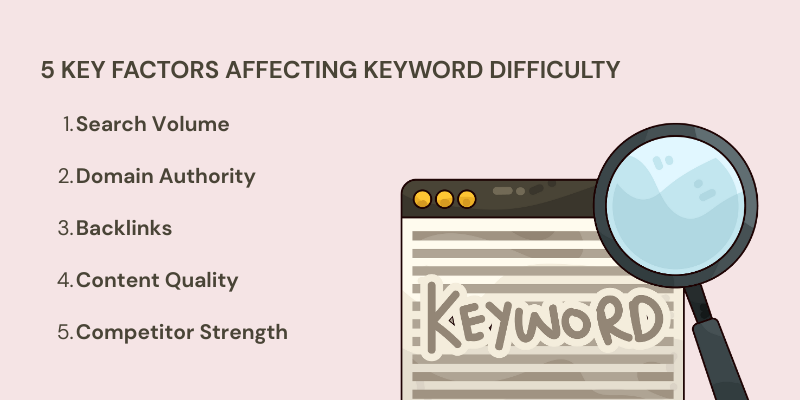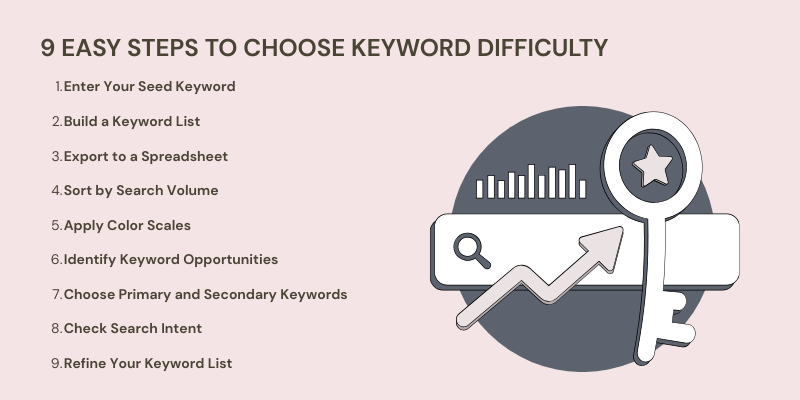When we talk about what is keyword difficulty in SEO, we’re basically asking: How hard will it be to rank for this keyword on Google (or any search engine)?
It’s like checking the level of competition before jumping into a game. Some keywords are tough because established websites with high authority are already targeting them.
If you go after these, you’ll likely need solid content, strong backlinks, and time to build authority.
On the flip side, keywords with low difficulty don’t have as much competition. They’re easier wins, though they usually bring in less traffic compared to the “big” keywords.
Knowing keyword difficulty helps you choose smarter.
Instead of guessing, you can decide whether it’s worth chasing high-competition terms or focusing on easier keywords that can get you results faster.
In this post, we will explore everything you need to know about keyword difficulty, matching your SEO goals with the right opportunities.
What is Keyword Difficulty?
Keyword difficulty refers to how challenging it is to rank for a specific keyword or search term on search engines like Google.

It is a critical metric in SEO because it helps marketers assess the level of competition for a keyword and determine the resources required to achieve high rankings, a process well-understood by any top digital marketing agency focusing on results-driven campaigns.
High-difficulty keywords typically require more content, backlinks, and optimization efforts, while low-difficulty keywords are easier to rank for but may have lower search volume.
Understanding Keyword Difficulty vs. Keyword Competition
When working with SEO, it's important to understand the distinction between "Keyword Difficulty" and "Keyword Competition." Although they may sound similar, they are two separate concepts that help in planning SEO strategies.
| Aspect | Keyword Difficulty | Keyword Competition |
|---|---|---|
| Definition | Measures how difficult it is to rank for a specific keyword in organic search results. | Refers to the level of competition in paid search when bidding for a keyword. |
| Focus Area | Organic Search (SERPs) | Paid Search (Google Ads) |
| Purpose | Helps assess the likelihood of ranking for a keyword based on competition from other websites and overall search engine optimization factors. | Indicates the level of competition you might face when bidding for a keyword in Google Ads. |
| Measurement | Usually represented as a score, ranging from low to high difficulty based on factors like domain authority, backlinks, and content quality. | Typically indicated by the "Competition" metric in Google Keyword Planner, which shows how many advertisers are bidding on that keyword. |
| Relevance | Most relevant for SEO efforts aiming to improve organic rankings over time. | Primarily relevant for paid search campaigns and ad strategy. |
| Examples | Ranking for "best digital cameras" or "buy running shoes" organically. | Competing with other advertisers for "digital camera sales" or "discount running shoes." |
Both Keyword Difficulty and Keyword Competition are crucial for SEO and PPC strategies, but they apply to different aspects of your online marketing efforts. Understanding the difference allows you to make more informed decisions in your digital marketing strategy.
The Importance of Keyword Difficulty in Keyword Research
When conducting keyword research, SEO teams typically prioritize content opportunities based on two key factors: search demand and competition. But how do you determine whether you have the potential to rank for a given keyword?
This is where keyword difficulty in SEO comes into play.
When optimizing your site for a new topic, it’s often most effective to target keywords that are easier to rank for, yet still attract a reasonable amount of search volume. These are commonly referred to as "low-hanging fruit" keywords. Since they face less competition, they can quickly drive traffic to your site without requiring heavy resources.
Focusing on low-difficulty keywords can also have significant long-term advantages. By optimizing content around long-tail keywords and strategically interlinking it, you can create a topic cluster around a specific subject. OOver time, this helps search engines recognize your website as an authoritative source, which can increase your chances of ranking for more competitive, high-traffic keywords. Centric, a digital transformation agency, helps businesses leverage such keyword strategies for better online visibility and growth.
Keyword difficulty meaning is crucial for understanding how much effort you'll need to rank for certain terms. A good strategy for new websites is to focus on SEO keyword difficulty that's on the lower end of the scale while gradually increasing the difficulty as your site gains authority and backlinks.
What Is a "Good" Keyword Difficulty Score?
A good keyword difficulty score varies depending on your SEO strategy and the competitiveness of your niche. However, here’s a general guideline:
- Low Difficulty (0-30): These are the easiest keywords to rank for. Although they tend to have lower search volumes, they’re ideal for new websites or for targeting longer-tail keywords. They represent prime opportunities for rapid wins.
- Medium Difficulty (31-60): These keywords are moderately competitive. They usually offer a balance between search volume and competition. Established websites with some domain authority can effectively target these keywords with optimized content.
- High Difficulty (61-100): These are the most competitive keywords, usually dominated by authoritative sites with strong backlinks. Targeting high-difficulty keywords typically requires substantial time, resources, and a well-established online presence.
Keyword difficulty tools can help you assess the competitiveness of a keyword, allowing you to prioritize efforts based on real-time data. If you're looking for a keyword difficulty tool free, many platforms offer basic analysis tools to help you get started. For more detailed insights, it’s worth investing in the best keyword difficulty tool.
Striking the Right Balance
Ultimately, the "best" keyword difficulty score depends on your website’s authority, available resources, and your overall SEO goals. The key is to strike a balance between targeting achievable keywords and aiming for those with substantial traffic potential. By leveraging low-difficulty keywords as stepping stones, you can build authority and gradually work your way up to more competitive keywords. In this way, understanding how to find keyword difficulty can guide your strategy and lead to better, more sustainable results in the long term.
5 Key Factors Affecting Keyword Difficulty
It includes search volume, domain authority, backlinks, content quality, and competitor strength, all influencing how challenging it is to rank for a keyword.

1. Search Volume
Keywords with higher search volume typically face more competition, as many businesses target these terms to capture larger audiences. This is particularly true in local SEO keyword research, where competition can vary significantly depending on geography and niche.
2. Domain Authority
Websites with strong domain authority are more likely to rank for competitive keywords. Higher authority sites are trusted by search engines, making it easier for them to rank.
3. Backlinks
The quality and quantity of backlinks a website has directly affect its ability to rank. Websites with a robust backlink profile tend to rank better for challenging keywords.
4. Content Quality
Well-structured, relevant, and detailed content is essential for ranking higher. High-quality content not only attracts more traffic but also increases the likelihood of earning backlinks.
5. Competitor Strength
The strength of the websites ranking for the keyword plays a significant role. If these top-ranking pages have high domain authority, backlinks, and optimized content, it becomes more challenging to outrank them.
How Keyword Difficulty is Measured?
Keyword difficulty is measured using SEO tools like SEMrush, Ahrefs, and Moz, which assign a score (0-100) based on competition, backlinks, and domain authority.
The score is derived based on several parameters: Search Volume, Competition, Backlinks, and Domain Authority.
1. SEO Tools
SEO tools like SEMrush, Ahrefs, Moz, and Ubersuggest are widely used to measure keyword difficulty.
These platforms analyze multiple ranking factors, including the strength of the competition, the quality of backlinks, content relevance, and domain authority, to provide a keyword difficulty score, similar to what is the digital marketing strategy that tracks users across the web?, which depends on data collection and user behavior tracking to assess performance.
2. Score Range
Keyword difficulty is typically measured on a scale from 0 to 100, where a higher score indicates greater difficulty. The score is derived based on several parameters:
- Search Volume: High search volume often correlates with high competition, which increases difficulty.
- Competition: If multiple strong competitors are targeting the same keyword, the difficulty increases.
- Backlinks: Pages with a high number of quality backlinks are often harder to outrank.
- Domain Authority: Websites with strong domain authority have a better chance of ranking for competitive terms, making the keyword more difficult.
3. Difficulty Rating
Keyword difficulty is usually categorized as:
- Low (0-29): Keywords with low difficulty are easier to rank for. These terms usually have lower search volume and less competition, making them ideal for new websites or those looking for quicker SEO wins.
- Medium (30-59): These keywords represent moderate competition. Ranking for these keywords will require a balanced approach, including high-quality content and strategic backlink building.
- High (60-100): Keywords in this range are highly competitive, usually with high search volume and multiple well-established competitors. Achieving a high ranking for these keywords requires significant SEO efforts, including high-quality content, extensive backlink strategies, and an authoritative website with strong domain metrics.
The score is derived based on several parameters: Search Volume, Competition, Backlinks, and Domain Authority. All of these contribute to understanding Google keyword ranking, which is a practical outcome of analyzing keyword difficulty.
9 Easy Steps to Choose Keyword Difficulty
When reviewing keyword difficulty scores, it’s not just about picking a specific number, it’s about truly understanding what is keyword difficulty and how it reflects the competition around a keyword.
The smartest strategy often involves a mix: pursue a few competitive keywords for long-term growth while building momentum with low to medium-difficulty keywords that offer quicker wins.

Keyword difficulty scores are a helpful metric to gauge the level of competition for each keyword, but they’re just one piece of the puzzle.
Here’s how you can approach it:
1. Enter Your Seed Keyword
Enter your seed keyword into an SEO tool that provides search volume and keyword competition or difficulty metrics.
2. Build a Keyword List
Select all relevant keyword options and save them in a list.
3. Export to Spreadsheet
Export the list to Google Sheets or Excel for further analysis.
4. Sort by Search Volume
Sort the list by search volume, starting with the highest.
5. Apply Color Scales
Apply color scales to the search volume and keyword difficulty columns for easier visual comparison, just as learning how to search a word on a website makes analyzing content or finding key information more efficient during the SEO research process.
6. Identify Keyword Opportunities
Look for keywords with high search volume and lower difficulty scores.
7. Choose Primary and Secondary Keywords
Choose one or two primary keywords and a few secondary ones that best fit your goals.
8. Check Search Intent
Evaluate the search intent behind these keywords and review the pages that are currently ranking. Be honest about whether you can create content that fulfills this intent.
9. Refine Your Keyword List
Remove any keywords that don’t align with the search intent or your content strategy.
Keep in mind the authority of your domain. If you’re a large brand with high authority, you may not need to worry as much about competition, whereas smaller businesses should focus on less competitive keywords to gain traction in search results.
Explore Our Digital Marketing Services!
Keyword Difficulty and its Impact on Strategy
Keyword difficulty directly shapes how you plan and execute your SEO strategy.
High-difficulty keywords usually mean strong competition from authoritative websites, which often require significant investment in high-quality content, backlinks, and domain authority to stand a chance of ranking.
While these keywords can deliver large amounts of traffic, they also demand more time, effort, and resources.
On the other hand, low-difficulty keywords give you quicker wins.
These terms may not drive massive traffic, but they’re easier to rank for and can steadily build your site’s visibility.
Targeting these keywords helps smaller or newer websites gain traction before competing for harder, high-volume terms—a strategy often recommended by agencies offering digital marketing services to ensure steady growth and ROI.
The smartest strategy is often a mix: pursue a few competitive keywords for long-term growth while building momentum with low to medium-difficulty keywords.
This approach reflects broader marketing efforts, similar to what are five marketing strategies that retailers spend half of their annual budget on?, where prioritization is key to balancing short-term wins with long-term gains.
This balance ensures you’re not only chasing big opportunities but also capturing realistic traffic that supports your overall business goals.
6 Key Tools to Analyze Keyword Difficulty
To figure out how competitive a keyword is, you’ll need the right tools.

These platforms provide keyword difficulty scores, search volume, and competitor analysis, helping you decide which terms are worth targeting in your SEO strategy. Using SEO ranking report software further enhances this process by giving consistent performance tracking and historical data.
1. SEMrush
SEMrush offers a Keyword Difficulty metric that evaluates competition based on top-ranking domains, making it a go-to tool for any tech marketing agency looking to break into competitive SERPs with data-driven insights. It also provides related keywords, trends, and SERP features to help refine your targeting.
2. Moz Keyword Explorer
Moz calculates keyword difficulty by analyzing domain authority and page authority of competitors. It also suggests keyword opportunities and shows organic CTR estimates.
3. Ubersuggest
Created by Neil Patel, Ubersuggest provides free and paid keyword analysis. It gives difficulty scores, keyword ideas, and competitor page insights, making it a good budget-friendly choice.
4. Google Keyword Planner
Google Keyword Planner is a free tool from Google Ads, primarily designed for advertisers but useful for SEO research. When choosing between tools, it's also useful to consider Duckduckgo vs Google, especially if you're analyzing search trends or privacy-conscious user behavior.
5. KWFinder (by Mangools)
KWFinder is known for its simple interface. It shows keyword difficulty, search trends, and long-tail keyword suggestions, features that make it a valuable tool for those offering SEO services and looking for efficient keyword discovery.
6. Serpstat
Serpstat offers keyword difficulty analysis along with competitor tracking and backlink data, making it a strong contender among the best SEO reporting software options for marketers seeking a full-featured SEO solution.
It’s an all-in-one SEO tool that helps you evaluate whether ranking for a keyword is realistic within your niche.
Comparison of Keyword Difficulty Tools
This table compares six of the top tools for analyzing keyword difficulty, helping you decide which one best fits your SEO needs. Each tool is rated out of 5 stars based on key factors such as keyword difficulty analysis, user interface, additional features, and overall value.
| Tool | Keyword Difficulty Metric | Additional Features | Ease of Use | Value for Money | Rating |
|---|---|---|---|---|---|
| SEMrush | Top-ranking domain competition | Related keywords, trends, SERP features, competitor analysis | 4/5 | High (Paid tool) | ★★★★☆ (4.5) |
| Moz Keyword Explorer | Domain and page authority comparison | Organic CTR estimates, keyword opportunities | 4/5 | Moderate (Paid tool) | ★★★★☆ (4) |
| Ubersuggest | Keyword difficulty score, competitor data | Keyword ideas, free and paid plans | 3/5 | High (Free/Paid) | ★★★☆☆ (3.5) |
| Google Keyword Planner | Search volume, competition from ads | Primarily designed for advertisers, keyword trends | 3/5 | Free (Ads-based) | ★★★☆☆ (3) |
| KWFinder | Keyword difficulty and search trends | Long-tail keyword suggestions, simple interface | 5/5 | Moderate (Paid) | ★★★★★ (5) |
| Serpstat | Keyword difficulty, competitor tracking | Backlink data, all-in-one SEO tool | 4/5 | High (Paid) | ★★★★☆ (4) |
How to Evaluate Keyword Difficulty?
To effectively evaluate keyword difficulty in SEO, using a tool like Keyword Explorer is crucial. This tool helps you analyze the competitiveness of your target keywords and find the best keywords to rank for. Here's a step-by-step guide on how to use the tool and interpret SEO keyword difficulty scores:
1. Enter Your Seed Keyword and Location: Begin by entering a seed keyword that is central to your content. Specify the location to ensure that the results are relevant to your target audience.
2. Review the Keyword Difficulty Metric: In the Keyword Difficulty tool free report, you'll see the difficulty score for your seed keyword, along with a list of related keywords. The keyword difficulty meaning can help you understand how hard it is to rank for that keyword, based on factors like competition, search volume, and domain authority.
3. Analyze Related Keywords: For each keyword, you’ll also receive data on:
-
Search Volume: This shows how many people are searching for that keyword.
-
SERP (Search Engine Results Page) Analysis: You can see the existing competition, including the strength of the sites already ranking for that keyword. This analysis helps determine if you can compete effectively.
FAQs: What is Keyword Difficulty?
What is keyword difficulty with example?
Keyword difficulty (KD) refers to how hard it is to rank on the first page of search engine results for a particular keyword. It takes into account factors like the number and quality of backlinks, domain authority, content quality, and how competitive the search results are for that term. For example, the keyword "buy shoes online" might have a high keyword difficulty due to strong competition from established e-commerce websites, while "buy handmade shoes in London" might have lower difficulty due to fewer competing pages.
What is a good keyword difficulty score?
A good keyword difficulty score depends on your site's authority, but generally, a score under 30 is low competition, 30-50 is moderate, and above 50 is high difficulty. For new websites, targeting keywords with low keyword SEO difficulty (below 30) is ideal.
How to find keyword difficulty?
You can find keyword difficulty using keyword difficulty tools like Ahrefs, SEMrush, or free tools like Ubersuggest. These keyword difficulty tools assess competition to give you a score, helping you understand how hard it will be to rank for a particular term.
What do you mean by keyword?
A keyword is a word or phrase people search for in engines. It’s crucial for SEO as it helps search engines understand content. For example, "best pizza in New York" is a keyword targeted by restaurants for better visibility.
How is keyword difficulty calculated?
Keyword difficulty in SEO is calculated by analyzing factors like website authority, backlinks, and content relevance. Keyword difficulty tools use these factors, along with algorithms, to provide a score that predicts how competitive a keyword is.
How is KD different from search volume?
Keyword difficulty measures competition, while search volume indicates how often a keyword is searched. A keyword can have high search volume but low SEO keyword difficulty if competition is low, or vice versa.
Why does KD matter in SEO planning?
Keyword difficulty is vital in SEO planning as it helps prioritize keywords. Knowing the keyword difficulty scale lets you choose terms with the best balance of search volume and competition, ensuring your SEO efforts are focused effectively.
Conclusion
Analyzing what is keyword difficulty is a vital step in developing an effective SEO strategy. By understanding how competitive a keyword is, you can make informed decisions on which terms to target based on your website’s current authority, available resources, and long-term goals. Thus, by understanding how competitive a keyword is, you can make informed decisions on which terms to target based on your website’s current authority, resources, and goals. Focusing on keywords with manageable difficulty allows you to prioritize efforts on achievable rankings. Just like choosing the best website builders for small business, keyword targeting should match your current resources, goals, and stage of growth.
A thorough analysis of keyword difficulty also helps optimize the allocation of resources, ensuring you don’t over-invest in highly competitive keywords that may not yield immediate results. It allows for a balanced approach targeting a mix of high-traffic, low-difficulty keywords for quick wins, while gradually building authority to compete for more challenging terms across the top search engines, ensuring visibility where it matters most. Ultimately, by integrating keyword difficulty into your SEO planning, you can ensure your strategy is both realistic and effective, driving relevant traffic to your website, improving rankings, and helping increase conversion rate in a sustainable way.









